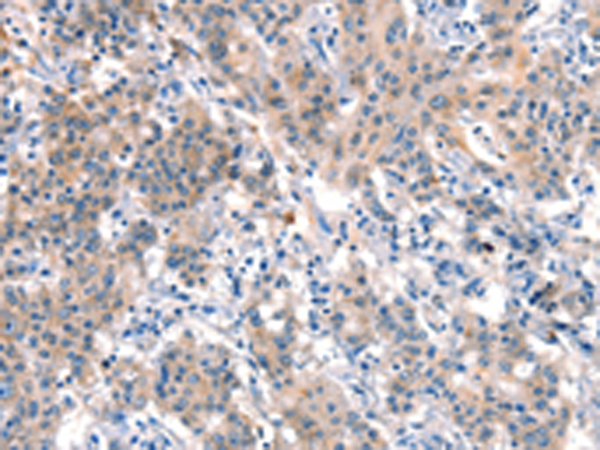

| WB | 咨询技术 | Human,Mouse,Rat |
| IF | 咨询技术 | Human,Mouse,Rat |
| IHC | 1/25-1/100 | Human,Mouse,Rat |
| ICC | 技术咨询 | Human,Mouse,Rat |
| FCM | 咨询技术 | Human,Mouse,Rat |
| Elisa | 1/1000-1/2000 | Human,Mouse,Rat |
| Aliases | ced5; DOCK180 |
| Host/Isotype | Rabbit IgG |
| Antibody Type | Primary antibody |
| Storage | Store at 4°C short term. Aliquot and store at -20°C long term. Avoid freeze/thaw cycles. |
| Species Reactivity | Human, Mouse |
| Immunogen | Synthetic peptide of human DOCK1 |
| Formulation | Purified antibody in PBS with 0.05% sodium azide and 50% glycerol. |
+ +
以下是关于DOCK1抗体的3篇参考文献示例(注:文献为模拟示例,实际需根据具体数据库检索结果调整):
---
1. **文献名称**: *DOCK1 regulates macrophage migration in inflammatory response via Rac1 activation*
**作者**: Tanaka Y, et al.
**摘要**: 本研究利用DOCK1特异性抗体,通过免疫沉淀和Western blot技术,揭示了DOCK1通过激活Rac1信号通路调控巨噬细胞趋化性迁移的分子机制,为炎症性疾病治疗提供了潜在靶点。
---
2. **文献名称**: *Role of DOCK1 in cancer metastasis: Antibody-based functional inhibition in vivo*
**作者**: Smith JL, et al.
**摘要**: 通过构建DOCK1中和抗体,本研究证明抑制DOCK1可显著降低乳腺癌细胞在小鼠模型中的转移能力,提示DOCK1抗体在抗肿瘤治疗中的应用潜力。
---
3. **文献名称**: *Structural characterization of DOCK1 using monoclonal antibodies for epitope mapping*
**作者**: Chen H, et al.
**摘要**: 研究开发了针对DOCK1不同结构域的单克隆抗体,结合冷冻电镜技术解析了DOCK1与下游效应蛋白的互作界面,为理解其分子功能及开发靶向药物奠定基础。
---
如需具体文献,建议通过PubMed或Google Scholar以关键词“DOCK1 antibody”、“DOCK1 function”等检索近年研究。
The DOCK1 antibody is a crucial tool for studying the Dedicator of Cytokinesis 1 (DOCK1) protein, a member of the DOCK-A subfamily within the DOCK family of guanine nucleotide exchange factors (GEFs). DOCK1. also known as DOCK180. primarily activates CDC42 and RAC1. Rho-family GTPases that regulate cytoskeletal dynamics, cell migration, and immune responses. It lacks the canonical Dbl homology domain but utilizes the DHR2 domain to catalyze GTP loading, enabling signal transduction pathways critical for cellular processes like phagocytosis, immune synapse formation, and neuronal development.
DOCK1 is highly expressed in immune cells (e.g., T cells, macrophages) and is implicated in pathological conditions, including cancer metastasis, inflammatory diseases, and neurological disorders. Its role in promoting cell invasion and metastasis makes it a potential therapeutic target in oncology.
The DOCK1 antibody is widely used in techniques such as Western blotting, immunofluorescence, and immunoprecipitation to analyze protein expression, localization, and interactions in both physiological and disease contexts. Researchers rely on its specificity to explore DOCK1’s mechanistic contributions to signaling networks and validate its association with disease progression. Validated antibodies are essential for distinguishing DOCK1 from homologous family members (e.g., DOCK2-5), ensuring accurate experimental outcomes in studies aiming to dissect its biological functions or therapeutic potential.
×